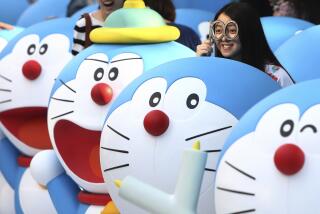One woman, 1,000 origami cranes, countless memories
It’s a Japanese tradition that is said to bring longevity and happiness. And by almost any measure, Saeko Oyama is living proof that it works.
Oyama, 76, is an expert in the ancient art of origami and teaches families the proper way to fold 1,000 cranes. It is in the folding that a person’s wish comes true, which is why these paper birds-in-motion are often hung on garlands as wedding decoration, only to be shelved, never again to take flight.
Oyama has changed that.
“Better to make it pretty,” she says.
What she does with those cranes has brought her distinction.
Since 1989, Oyama, whose clients reverently call her Mrs. Oyama, has been turning the birds — sacred creatures in Japanese lore — into delicately crafted wall art as wedding gifts. She learned basic folding as a schoolgirl in Japan, but she’s since expanded the art form.
After a customer arrives with an order for a 1,000-crane picture, Oyama says, she helps the client decide on a custom design: larger cranes, a family crest, a car. Then she begins the monthlong project with a sketch, while the client’s family gets to work.
With hundreds of pieces of 2 1/4 -inch foil paper, family members will fold each crane — or tsuru — one at a time. At a pace of five minutes or more per crane, some families fail to finish in time and give up. But those who complete all 1,000 bring the gold, silver and red birds in plastic bags to Oyama’s store. That’s when Oyama’s partner, Sharon Yonamine, goes to work, laying the cranes out, one on top of the other, texturing and gluing them to make the design. Eventually Oyama will mat the finished product on black velvet and create a custom frame.
But first, she conducts a thorough inspection.
“She is a perfectionist,” says Yonamine, who grimaces at the memory of having to redo a bonsai tree a few weeks ago. “You can be one-eighth of an inch off, and she’ll take the whole thing off and start over. It’s hard to tell — but she can see it.
“I think she’d be impossible to replace.”
That’s the thing. Oyama planned to retire at 70 but just couldn’t.
“They send me thank-you cards,” Oyama says, trying to explain why she keeps working. “We take a picture together. They usually send a wedding picture. It makes me more keep going.”
Of course, origami is not all Oyama does. For nearly 40 years, she has owned and operated Let’s Knit Yarn Shop — a humble, slightly cluttered store in Gardena. Hundreds of styles and colors of yarn are stuffed into cubbyholes along the right wall. In the back, handmade sweaters hang on a clothing rack as examples for customers who come into the store to knit and talk. Most often, the knitting gives way to the talking.
“We talk about our lives and about our husbands,” says Jane Shintani, who has been coming twice a week for two years. “Lady gossip.”
At first, the store sold only yarn, and the line was out the door because only Oyama stocked the specialty Japanese yarn customers craved. Before long she had added Japanese needlepoint — or bunka — but it was her 1,000-crane artwork that won her lasting acclaim.
Asian art curator Meher McArthur said she wasn’t aware of Oyama’s tiny store and knows of only one other artist in the country who makes 1,000-crane pictures. McArthur added that 1,000-crane artwork represents “a relatively new development” that is more Japanese American than traditional Japanese.
Oyama estimates that she has created several hundred one-of-a-kind works for clients from across the U.S. as well as from Japan. Today the pictures run about $675. But she still doesn’t charge for knitting lessons.
“They give me business; I give back something,” Oyama said. “I just cannot sell to the customer for high price. It’s a Japanese way of thinking. Customer come, and we treat nicely.”
Ultimately it’s customers like Linda Tanigawa who keep Oyama coming to work. On one Saturday, Tanigawa brings along her daughter, Trisha, who will perform all the labor for her mother’s picture. Linda Tanigawa’s 25th wedding anniversary is coming up in a year, and as they talk about possible designs, Oyama gives the 22-year-old Trisha Tanigawa a private folding lesson.
Oyama makes her first fold with the white side of the paper facing out — a counterintuitive trick that draws a gasp from Trisha Tanigawa. Several folds later, Oyama pauses.
“Then you’re going to push it in,” she says, popping a crane neck out of nowhere.
“Oh my gosh,” Trisha Tanigawa says, “OK!”
Oyama settles back into her seat at the knitting table. She says she’s known the Tanigawas for what seems like forever.
“Almost 40 years’ business,” she says. “The first generation came, and we’d drink tea and talk story for the old times about how hard life was and how they did it. And then they get a little bit old, and they cannot come here, but the daughter comes. And then now, granddaughter comes.
“I am lucky.”
twitter.com/mattstevensLAT
More to Read
Sign up for Essential California
The most important California stories and recommendations in your inbox every morning.
You may occasionally receive promotional content from the Los Angeles Times.











